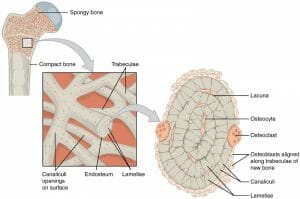Spongy Bone Definition
Spongy bone, also known as cancellous bone or trabecular bone, is a very porous type of bone found in animals. It is highly vascularized and contains red bone marrow. Spongy bone is usually located at the ends of the long bones (the epiphyses), with the harder compact bone surrounding it. It is also found inside the vertebrae, in the ribs, in the skull and in the bones of the joints. Spongy bone is softer and weaker than compact bone, but is also more flexible. It is characterized by a lattice-like matrix network called trabeculae (Latin for little beam) that gives it its spongy appearance. The figure below illustrates spongy bone.

Structure of Spongy Bone
Spongy bone is composed of cells called osteocytes that sit in small cavities known as lacunae. The lacunae and their accompanying osteocytes are housed in the trabeculae matrix of the bone along with the bone marrow. Blood vessels travel through the harder compact bone to the spongy bone, supplying it with the materials necessary to create blood cells. Osteocytes positioned close to a blood vessels can take on nutrients and expel waste products through tiny interconnecting channels on the surface of the trabeculae called canaliculi. Spongy bone can be converted to compact bone by the action of osteoblasts, bone cells that secrete the material that creates the compact bone matrix. It is through this process that the long bones in a human embryo develop.
Functions of Spongy Bone
Storage of Bone Marrow
Bone marrow, also called myeloid tissue, is formed when the trabecular matrix crowds blood vessels together and they condense. While compact bone is denser and has fewer open spaces, spongy bone is ideal for making and storing bone marrow within the lattice-like trabeculae network. Compact bone stores yellow bone marrow, which is composed primarily of fat, in its medullary cavity. Spongy bone contains red bone marrow that is used in erythropoiesis.
Site of Erythropoiesis
Inside spongy bone, red blood cells are produced in the red bone marrow at a rate of about 2 million per second. This rapid production is made possible by the highly vascularized nature of the spongy bone, which can deliver adequate amounts of the glucose, lipids, amino acids and trace elements required to make red blood cells. When old and damaged red blood cells are ready to die, they return to the bone marrow, where they are phagocytized by macrophages. This process also occurs in the liver and spleen.
Reduces the Weight of the Skeleton
The light weight and low density of spongy bone balances out the heavier and denser compact bone to reduce the overall weight of the skeleton. This makes it easier for muscles to move the limbs.
Adds Strength and Flexibility to Bones
The trabeculae of spongy bone tend to form along lines of stress, giving the bone strength and flexibility in that area. Spongy bone is also present in the joints of the body and acts as a shock absorber when we walk, run and jump.
Mineral Storage
The human skeleton stores 99% of the body’s calcium and 85% of the phosphorous. The mineral content of blood must be tightly regulated to ensure proper functioning of the muscles and nervous system. Release of minerals into the bloodstream is accomplished quickly when needed, and this action is often mediated by hormones.
Evolutionary Changes in Human Spongy Bone
The modern human skeleton is unique in that it has a low trabecular density compared to its size. About 20% of the human skeleton is spongy bone. In comparison, it makes sense that the skeleton of a chimpanzee is almost entirely composed of spongy bone. Tests on early human bones show they contained a higher percentage of spongy bone than modern humans. To examine this finding further, recent research has compared the trabecular density of modern human skeletons to those of chimpanzees and early humans who lived millions of years ago. The study was designed to determine at what point human in evolution the trabecular bone density in humans decreased. The results of the research show that lower trabecular bone density in modern humans is a recent event, and is probably caused by increasingly sedentary lifestyles and a reliance on technology.
Quiz
1. Which of the following statements is NOT true about spongy bone?
A. It is denser than compact bone.
B. It is the location of the bone marrow.
C. It is less dense than compact bone.
D. It is found in the bones of joints.
2. The bone cells located in the trabecular matrix of spongy bone are called _______________.
A. Marrow
B. Osteoblasts
C. Osteocytes
D. Osteoclasts
References
- Bone marrow. (n.d.). The Free Dictionary – Medical Dictionary. Retrieved May 3, 2017 from http://medical-dictionary.thefreedictionary.com/bone+marrow.
- Habiba et.al. (2015). Recent origin of low trabecular bone density in modern humans. Proceedings of the National Academy of Sciences. 112(2), 336-371. doi: 10.1073/pnas.1411696112.
- OpenStax. (2017). Anatomy and Psychology. [online textbook]. Retrieved from https://cnx.org/contents/FPtK1zmh@8.81:kwbeYj9S@4/Bone-Structure.
- OpenStax. (2017). Anatomy and Psychology. [online textbook]. Retrieved from https://cnx.org/contents/FPtK1zmh@8.81:9SrcxH7k@5/Erythrocytes.
